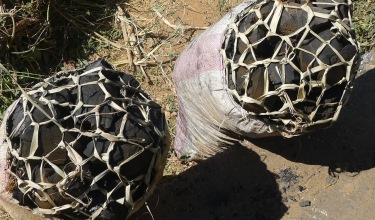My first experience with natural dyeing occurred many years ago. My first teacher, Mabel Myers, was a Navajo weaver who taught at Navajo Community College in Arizona (now called Dine College), where I was studying for a year during college. After spinning wool for my first rug on a long Navajo spindle (my first spinning), we went to the Lukachukai Mountains, where we gathered some leaves (I don’t know what kind) and white, powdery alum from the ground. When I asked Mabel how she knew that this was “alum” she took a taste. That’s how she knew!
We returned to the classroom. The yarn, leaves, and alum mordant all went into a dyepot and cooked for a while. We obtained brown, gold, and orange colors. The hues were deep and rich and they are still in that wool today, nearly 50 years later.

Since that first experience with natural dyes I have learned a lot about dyeing. Now I know that the BEST method of dyeing is to apply the mordant first, and then the dye, after rinsing out any excess mordant. This is the approach used by professional dyers and in industry. It is the most economical use of both dye and mordant. When mordant and dye bind together, preferable IN the textile, an insoluble compound is made, called a lake. If mordant and dye go into the dyepot together, some of the mordant and dye will bind together in the bath before ever having a chance to penetrate inside the textile.
While in Madagascar last month, I watched dyers add bark (the dyestuff), raffia (the textile), and crystalized alum (the mordant), to the dyebath all at the same time. My “professional dye knowledge” told me this was not the best approach. But then I began to think.
All of the dyeing here was done over a small wood fire. Wood is scarce. Madagascar is a seriously de-forested country. Charcoal is still made regularly from wood and used for nearly all cooking. The women were very skilled at controlling temperature by increasing or decreasing the amount of wood on the fire or moving it closer or further away. Perhaps the process is optimized to conserve the most valuable resource: the fuel.
Maybe time is the most valuable resource. The women worked together but their dyeing activity went hand-in-hand with childcare and there were many small children around, observing and participating when appropriate. When everything goes into the pot together the dye process takes less time.

Or maybe the dyepot itself was the most valuable resource. I only saw two pots. Pre-mordanting would require not only a single use of a pot, but might also necessitate the storage of mordanted textiles while they awaited dyeing.
Exposure to dyers in different parts of the world causes me to have a more open mind about process. It encourages me to think more about what I am doing and why I do it. The “BEST” process is not always best for everyone.







I love this post and the perspective you reveal.
Thank you for sharing your insights.
Happy Summer Solstice.
They are not only saving fuel but valuable water, too! If I pre-mordant I now cold mordant only using a little boiling water to dissolve the alum, but I now generally mordant and dye ate the same time in the same pot as Michel Garcia does.
Yes, You’re absolutely right about the water. I always take that for granted, since I live where it’s plentiful but I know that everyone doesn’t have that luxury.
What great experiences! I would love to have a Dine mentor!
Thank you for this, I really appreciate your perspective. I have felt similarly working with dyers in other parts of the world… it is so easy to settle into a dogma based on our own daily life variables. Your experience is beautifully written!
Catharine — what a thoughtful piece. Thanks for keeping me on your mailing list.
Lynn
On Wed, Jun 21, 2017 at 2:53 PM, Natural Dye: Experiments and Results wrote:
> Catharine Ellis posted: “My first experience with natural dyeing occurred > many years ago. My first teacher, Mabel Myers, was a Navajo weaver who > taught at Navajo Community College in Arizona (now called Dine > College), where I was studying for a year during college. After spinnin” >
Food for thought! Thank you Catharine.
Catherine isn’t it wonderful that we’re living long enough to question our assumptions? Great post.
Absolutely!. Time does give you a good perspective.
I love this post too. So beautiful. Thank you Catherine. The writing and the photo of the weaving. Gorgeous. I long for a Native American mentor/teacher because that is what I want most to learn. Any suggestions on how to find that here in Appalachia? Also, can I scoop alum up off the ground around here anywhere?
I started naturally dyeing, decades ago, using the ‘one pot’ method. It wasn’t until fairly recently that I have been told to keep the two stages separate…… don’t really see a difference in my results. And bringing up the idea of water conservation (I live in the Southwest), I might go back to my
‘old ways’
Nice perspective….. thank you!
It does make sense from the perspective of saving water and that is certainly an issue for you. What is the the fiber you are dyeing? I would have said that the one-pot method would never work for cellulose but they were dyeing raffia in Madagascar. There is always more to learn…..
A perceptive understanding, seeing the many aspects of how dyeing is appropriate in differing circumstances. I love how a deeper understanding enriches ones own practice and teaching. I remember talking to my son’s classmate’s Navajo mom through her son, he translating. I asked her if she was a weaver and she looked at me with eyes that said of course I weave, but I am myself, (daughter mother etc). It was a good lesson for me.